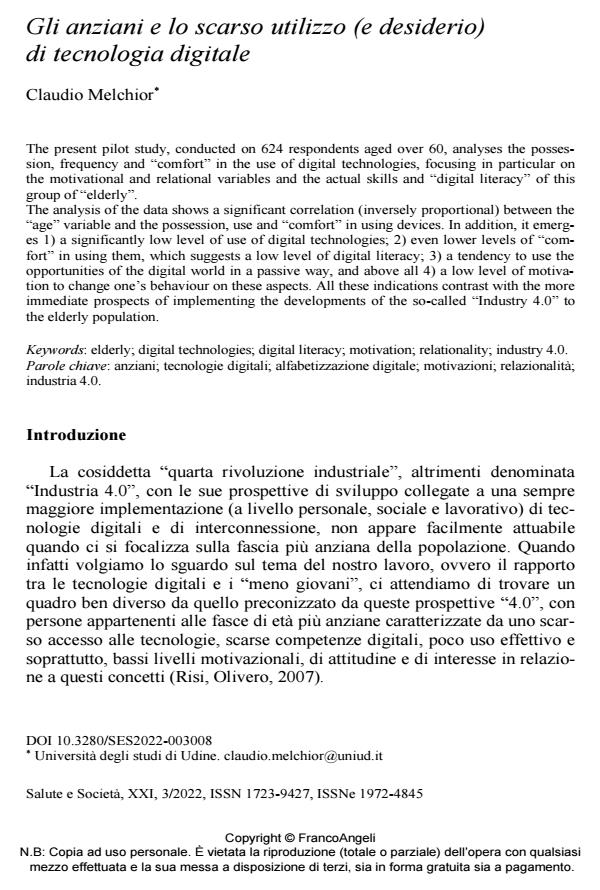Gli anziani e lo scarso utilizzo (e desiderio) di tecnologia digitale
Titolo Rivista SALUTE E SOCIETÀ
Autori/Curatori Claudio Melchior
Anno di pubblicazione 2022 Fascicolo 2022/3
Lingua Italiano Numero pagine 15 P. 106-120 Dimensione file 420 KB
DOI 10.3280/SES2022-003008
Il DOI è il codice a barre della proprietà intellettuale: per saperne di più
clicca qui
Qui sotto puoi vedere in anteprima la prima pagina di questo articolo.
Se questo articolo ti interessa, lo puoi acquistare (e scaricare in formato pdf) seguendo le facili indicazioni per acquistare il download credit. Acquista Download Credits per scaricare questo Articolo in formato PDF

FrancoAngeli è membro della Publishers International Linking Association, Inc (PILA)associazione indipendente e non profit per facilitare (attraverso i servizi tecnologici implementati da CrossRef.org) l’accesso degli studiosi ai contenuti digitali nelle pubblicazioni professionali e scientifiche
The present pilot study, conducted on 624 respondents aged over 60, analyses the possession, frequency and "comfort" in the use of digital technologies, focusing in particular on the moti-vational and relational variables and the actual skills and "digital literacy" of this group of "el-derly”. The analysis of the data shows a significant correlation (inversely proportional) between the "age" variable and the possession, use and "comfort" in using devices. In addition, it emerges 1) a significantly low level of use of digital technologies; 2) even lower levels of "comfort" in using them, which suggests a low level of digital literacy; 3) a tendency to use the opportuni-ties of the digital world in a passive way, and above all 4) a low level of motivation to change one’s behaviour on these aspects. All these indications contrast with the more immediate pro-spects of implementing the developments of the so-called "Industry 4.0" to the elderly population.
Parole chiave:anziani; tecnologie digitali; alfabetizzazione digitale; motivazioni; relazionalità; industria 4.0.
- Digitalizzazione e invecchiamento, tra sfide e risorse Giovanni Cellini, in SALUTE E SOCIETÀ 1/2025 pp.83
DOI: 10.3280/SES2025-001006 - Le ICT nei contesti di fragilità e ageing: la sfida relazionale Fausto Pagnotta, in WELFARE E ERGONOMIA 1/2023 pp.199
DOI: 10.3280/WE2023-001017 - Security of Personal Data in Cyberspace in the Opinion of Students of the University of Udine Claudio Melchior, Urszula Soler, in Cybersecurity and Law /2024 pp.227
DOI: 10.35467/cal/188451 - Perspectives and Experiences on eHealth Solutions for Coping With Chronic Pain: Qualitative Study Among Older People Living With Chronic Pain Annalisa De Lucia, Valeria Donisi, Ilenia Pasini, Enrico Polati, Lidia Del Piccolo, Vittorio Schweiger, Cinzia Perlini, in JMIR Aging /2024 pp.e57196
DOI: 10.2196/57196
Claudio Melchior, Gli anziani e lo scarso utilizzo (e desiderio) di tecnologia digitale in "SALUTE E SOCIETÀ" 3/2022, pp 106-120, DOI: 10.3280/SES2022-003008